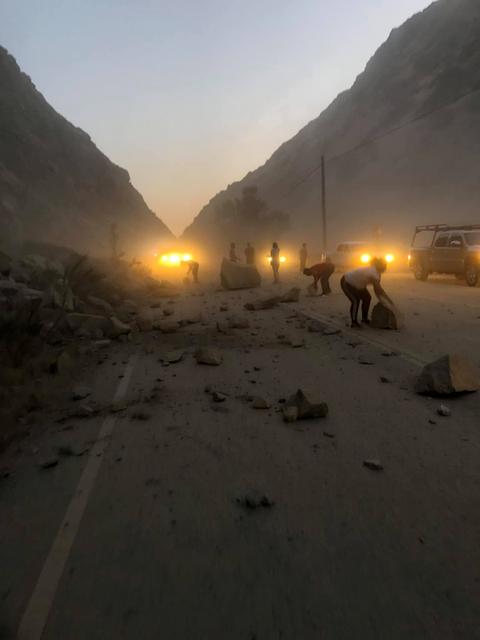LOS ANGELES, (Reuters) – Emergency officials in Southern California’s high desert braced for strong, potentially dangerous aftershocks from a major earthquake that damaged buildings, ruptured gas lines and sparked numerous fires near the quake’s remote epicenter.
The powerful magnitude 7.1 tremor rocked the Mojave Desert town of Ridgecrest near Death Valley National Park as darkness fell on Friday night, jolting the area with eight times more force than a 6.4 quake that had struck the same area 34 hours earlier.
California Governor Gavin Newsom requested federal assistance and placed the state Office of Emergency Services (OES) on its highest alert.
“We have significant reports of fires, structural fires, mostly as a result of gas leaks or gas line breaks,” OES Director Mark Ghilarducci told a late-night news conference on Friday.
The quake also caused water main breaks and knocked out power and communications to parts of Ridgecrest, a city of about 27,000 that lies about 125 miles (202 km) northeast of Los Angeles.
No fatalities or serious injuries were reported from either quake, police said. But Ghilarducci said the full extent of damage would not be known before daybreak on Saturday.
“This was a very large earthquake, and we also know there’s going to be a series of aftershocks as a result of the main quake,” Ghilarducci said, adding his agency faced a “challenge” getting needed resources to the isolated quake zone. “This is not going to be something that’s going to be over right away.”
Friday’s earthquake was widely felt across Southern California, including greater Los Angeles, where shaking in some areas lasted about 40 seconds. Low-level rumbling extended as far north as the San Francisco Bay area and beyond to Reno, Nevada, and as far east as Phoenix, Arizona.
Seismologists said the initial quake on Thursday, and dozens of smaller ones that followed it, proved to be foreshocks to Friday’s much larger temblor, which now ranks as Southern California’s most powerful since a 7.1 quake that struck near a U.S. Marine Corps base in the Mojave Desert in 1999.
The U.S. Geological Survey said Friday’s big quake was immediately followed by at least 16 aftershocks of magnitude 4 or greater and warned of a 50 percent chance of another magnitude 6 quake in the days ahead.
South of Ridgecrest, there were reports of a building collapse and gas leaks in the small town of Trona, home to about 2,000 residents, Ghilarducci said.
A rockslide closed State Road 178 in Kern County, and video footage posted on Twitter showed a stretch of road had buckled.
Luke Smith, owner of Furys Sports Bar in Ridgecrest, said in a phone interview that Friday’s quake shook tiles lose from the ceiling, slightly damaging his bar and knocking down some bottles.
Southern California’s Metrolink commuter rail service reported delays on several of its lines for precautionary track inspections due to Friday’s earthquake.
The last major destructive quake to hit Southern California was the 6.7 magnitude Northridge quake in 1994, which struck a densely populated area of Los Angeles. It killed 57 people and caused billions of dollars in property damage.
The comparatively limited extent of damage from Friday’s quake, packing greater force than the Northridge event, was a function of its location in a remote, less developed area.
Its ground motion, however, startled seismically-jaded Southern Californians over a wide region.
Pools in Los Angeles sloshed wildly, and TV cameras at major league baseball’s Dodger Stadium were shaking as they filmed the night game between the Los Angeles Dodgers and San Diego Padres.
A television anchorwoman ducked under her desk in midst of a local newscast as shouts of “get under a desk” were heard in the background.










